If you’re interested in playing bass, you might wonder whether you can plug a bass guitar into your guitar amp.
In this guide, let’s look at whether you can use your guitar amp to play bass guitar or whether you need to buy a dedicated bass amp.
If you want to learn how to play bass, a good starting point is to work on these Bass Guitar Exercises.
If you have guitar pedals and are interested in using them with a bass, find out if you can use your guitar pedals for bass in this guide.
An alternative to playing bass through a guitar amp is to make your guitar sound like a bass. Find out how you can make your guitar sound like a bass in this guide.
Can You Plug a Bass Into a Guitar Amp
Yes, you can plug a bass into a guitar amp. While guitar amps aren’t designed to handle bass input, it will work. But there is a risk you can damage your guitar amp with a bass at a high volume.
Plugging a bass guitar into an amp is simple as both bass and guitar use the same leads.
Simply plugging your bass into the guitar amp’s input will work.

But before you plug a bass into your guitar amp, let’s look at the potential risk and how to make sure you don’t blow up your amp.
Differences Between a Bass Amp and a Guitar Amp
The main differences between a bass amp and a guitar amp are the speaker size, the power output, the amp features, and the frequency range.
Bass guitars use very low frequencies that move a lot of air. When you hear a bass at a gig, you’ll feel the air move more than you hear it.
To do this, bass guitar amps tend to use larger speakers (eg: 15 inch) and use a lot of power to move the speaker.
Guitars use a higher frequency range compared to bass guitars, so guitar amps are designed to use smaller speakers (eg: 8-12 inch) and drive those speakers in different ways.
This is why there is a potential risk to your guitar amp when you plug a bass into it. Guitar amps aren’t designed to drive the speaker in the same way a bass amp is designed to push it.
If you were to crank your guitar amp with a bass plugged in, the low frequencies of the bass guitar can quickly become an issue for your guitar amp’s speaker.
While small bass practice amps use small speakers (eg: 8 inch), they’re still designed to drive the speaker in different ways than a guitar amp with the same size speaker.
The below animation shows a subwoofer speaker vibrating. Notice how far the middle of the speaker moves.

Subwoofers and bass amps have to move a wide distance to play low frequencies.
Now imagine a guitar amp trying to vibrate as far as this. Guitar amps don’t need to handle super-low frequencies, so they’re not designed to move very far when they vibrate.
If a guitar amp has the volume cranked up and you try to play a bass through it, the sound will clip (bad sounding distortion) and it may damage the speaker.
How to Tell a Bass Amp From a Guitar Amp
Telling a bass guitar amp apart from a guitar amp is easy once you know what to look for.
You can tell a bass amp from a guitar amp by the size of the speaker and the features on the amp. Bass amps usually have larger speakers and less controls than guitar amps.
Here are a few examples to help you learn the difference between a bass amp and a guitar amp.
Bass vs Guitar Practice Amps
When comparing small bass and guitar practice amps, it can be hard to tell them apart.
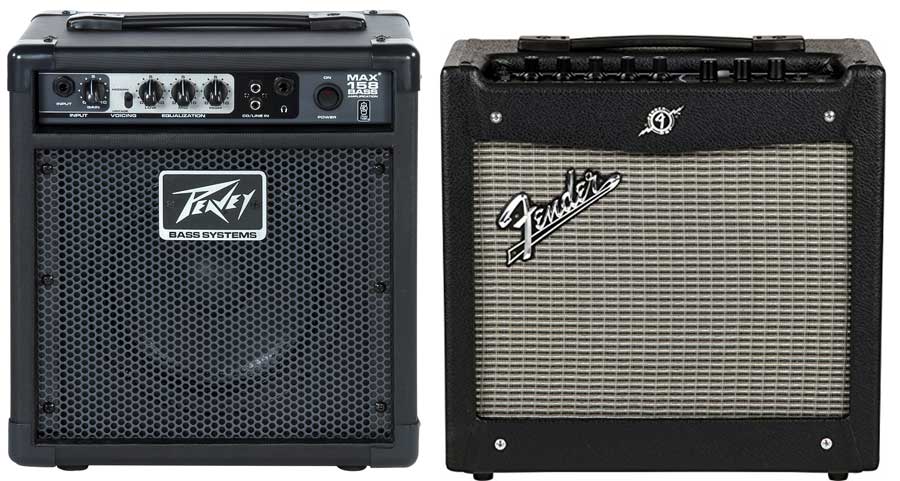
The clear giveaway that the left amp is a bass amp is it has ‘Bass Systems’ printed on the front.
A lot of bass amps will have Bass written somewhere on it or will use a ‘B’ in the model number (eg: Vox Pathfinder 10B).
If you look at the number of knobs on the two above amps, you’ll notice that the guitar amp (on the right) has far more knobs and controls. This is common as small bass amps tend to only use a few knobs for volume and EQ.
Small guitar amps usually pack in more features such as multiple channels, dedicated gain knobs and inbuilt effects.
Bass vs Guitar Combo Amps
With larger combo amps, the differences between a bass amp and a guitar amp start to become obvious.
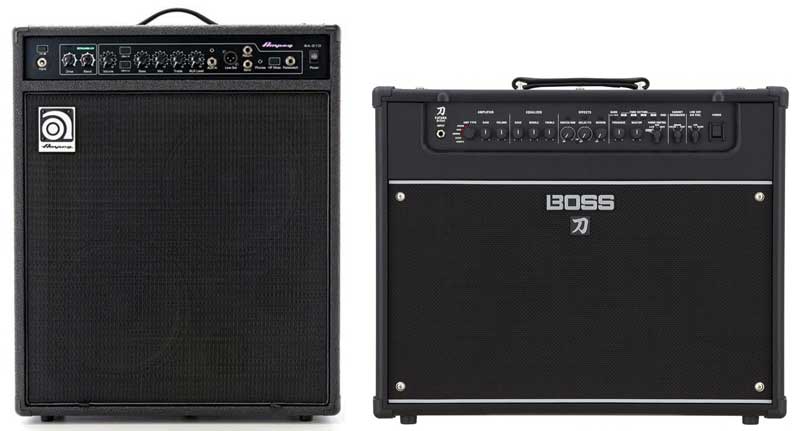
The amp on the left is a Ampeg BA-210 450-watt combo bass amp. Even from the name of the amp it should be obvious it is a bass amp.
450-watts is a ridiculous amount for a guitar amp, but very common for bass amps. The guitar amp on the right is 100w, which is common (and very loud) for a large guitar combo amp.
Notice the strange speaker layout in the bass amp (look closely to see the diagonal layout and port holes)? The height and arrangement of the speakers in the bass cabinet are designed to move as much air as possible. That’s why bass amps tend to be tall like this one.
Guitar amps on the other hand tend to be short and wide to give a punchy tone.
Here’s the front panel of the above bass amp so you can see how it differs from a guitar amp:

You might notice some strange features on the front panel such as the line out jack. This is a common feature on bass amps where they can plug directly into a mixer.
Bass vs Guitar Stack Amps
When comparing bass and guitar stack amps, the differences are obvious at a glance:
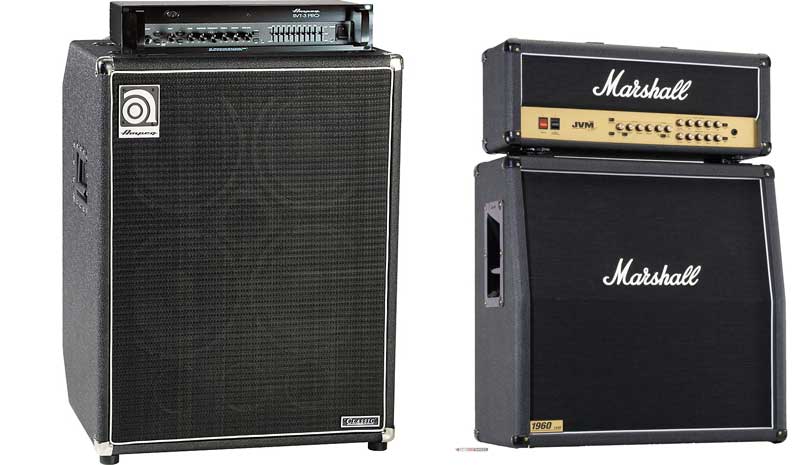
Guitar amps use a maximum of 12 inch speakers (usually 4×12 as shown above), while bass stack amps can use massive speakers.
Some bass cabinets will house one large 15 inch speaker, while others will cram a lot of smaller speakers in.
Even at this size, you can see that the bass amp panel still has a very limited number of knobs. This one includes EQ sliders, but the other features remain basic compared to a typical guitar amp.
How a Bass Sounds Through a Guitar Amp
When you plug a bass into a guitar amp, don’t expect it to sound as good as a real bass amp. Guitar amps are designed to make guitars sound good, which doesn’t work very well with bass.
Here is a simple example of a bass played through a bass amp:
If you listen to this with headphones, you’ll hear how the bass sounds thick and rich in tone. The amp gives the bass plenty of clarity for a nice clean tone.
Now here’s the same bass played through a guitar amp on the clean channel:
The bass sounds muddy and lacks that clarity you can hear in the other example.
You might be able to tweak the tone with the amp’s EQ knobs and get something closer to a decent bass tone, but it will never sound as good as a real bass amp.
For at home practice on the cheap, this will work. But if you want to get serious about playing bass, you’ll need to find something that works with bass as explained below.
Guitar Amps That Work With Bass
What if you want to play bass and guitar, but don’t want to have to buy separate amps.
While you could use almost any amp as explained above, there are some amps that are designed to be used for both bass and guitar.
A guitar and bass hybrid amp (or a combined amp) can accept input from either bass or guitar. These amps are designed to play both instruments with good quality tone.
The Peavey Vypyr VIP 3 is designed to work with three different instrument inputs: electric guitar, acoustic guitar, and bass.
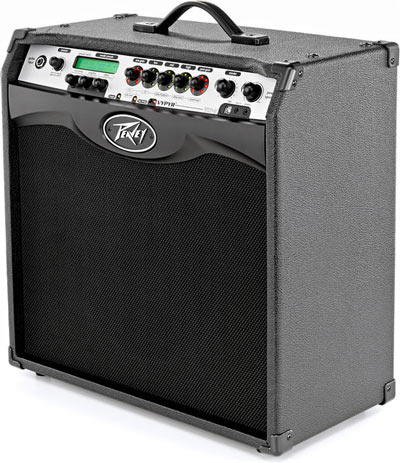
This means you can use the same amp for both bass and guitar (as well as acoustic if you want).
This type of amp is a modeling amp and there are different amp models available for both bass and guitar.
When you plug your guitar in, you can set up presets suitable for guitar tones. When you plug your bass in, you can set up different presets that suit bass.
This type of amp is perfect for at-home use when you want to practice bass and guitar.
If you wanted to play bass at gigs, this amp won’t be suitable. You would need a dedicated bass amp or plug directly into the mixer (known as DI: Direct Input).
Check out my review of the Peavey Vypyr VIP 3 here to learn more about the amp.
How to Use a Guitar Amp With Bass
Let’s say you have a small guitar amp you want to use with a bass guitar. Let’s look at how to get the best bass tone possible out of it.
First, make sure your amp is set to a clean channel. If your amp doesn’t have multiple channels, make sure the gain is set low to prevent any overdrive or distortion.
Remove any inbuilt effects from your tone such as reverb, chorus, or delay. While bass guitarists do use effects on occasion, start with a dry tone.
Next, plug your bass in with the master volume set low. Play around with the volume and see how high it will go before you start hearing the tone start to break up or it sounds like the speaker is struggling.
To get the best tone possible, adjust the EQ knobs. The most important EQ knob is the bass knob. Adjust that to see how much bass frequencies you can squeeze out of your amp.

The mid knob will change the overall shape of your tone. You will probably want to lower it to avoid your bass sounding boxy.
The treble knob will affect the higher frequencies. Depending on your amp, you may want to lower this to focus the attention on the lower frequencies.
The key to a good bass tone when using a guitar amp is to adjust the EQ and keep the tone as clean as possible. Every guitar amp is different, so play around with the EQ until you find the best settings to suit your bass.
No matter how much you tweak your guitar amp, it will never sound as good as a real bass amp.
So keep this in mind if you start taking bass seriously. A good quality bass amp can make bass incredibly fun to play.
Play Bass Through Your Computer
Instead of using a guitar amp to play bass, you can use your computer and any speakers attached to it.
The advantage of using your computer is that you can use any amp modeling software to model bass amps.
If you use decent speakers with your computer, they will give you a great bass tone. The tone will be far better than what your guitar amp can produce.

The above screenshot shows the modeling software AmpliTube 4 modeling a bass amp.
A cheap audio interface is all it takes to connect your guitar or bass to your computer.
Find out how to connect your guitar or bass to your computer in this detailed guide.
While the above guide is written for guitar, the exact same advice applies for connecting a bass to your computer.
Cheap Bass Amps
If you do want to learn bass and want a better bass tone than what your guitar amp can produce, you might want to buy a cheap bass amp.
A cheap bass amp will sound better than an expensive guitar amp and you won’t risk damaging your guitar amp’s speakers if you want to raise the volume.
Here are some popular and cheap bass amps worth checking out:
Fender Rumble 15 v3 Combo
The Fender Rumble 15 v3 is a 15watt combo amp with an 8-inch speaker.

It’s one of the cheapest bass amps you can get that still produces a great tone.
Other models are available if you want something bigger from 25 watts all the way up to 500 watts.
Find out about the Fender Rumble Range here (link to Amazon for details of all models).
Ampeg Bass Combo 20-watts
Ampeg is an incredibly popular bass amp brand and they produce a great range of amps.
The below bass combo amp is a 20-watt version with an 8-inch speaker.
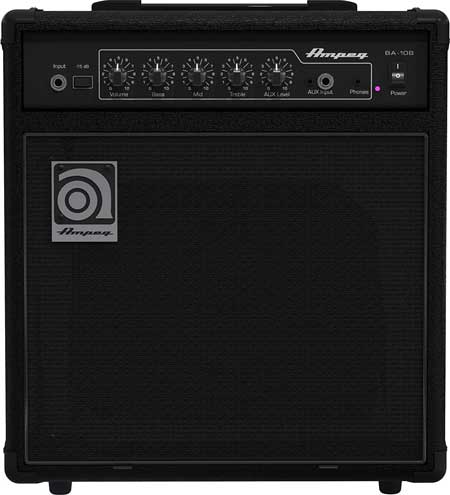
Other models in this range include 40, 75, 150, and 450-watts.
Find out about the Ampeg Combo Range here (link to Amazon for details of all models).
VOX AP2BS amPlug 2
One of the two bass amp options as shown above will suit most guitarists looking at getting into bass.
But if you’re looking for a really cheap option, the VOX amPlug 2 is about as cheap as it gets and can produce a good bass tone – as long as you’re happy to use headphones.
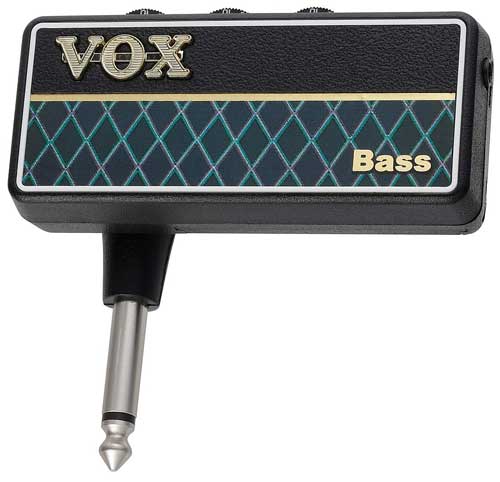
The amPlug range are mini headphone amplifiers you plug into your guitar or bass and can hear good quality amp tones through headphones.
This VOX amPlug 2 bass model is suitable for bass and doesn’t take up any room in your house.
It may not be quite the same as a real amp, but it may suit some people.
Find out more about the VOX amPlug 2 range in my review here.
Is Bass Guitar Easy To Learn
If you already know how to play guitar, you might wonder whether you can also start learning how to play bass.
Is bass easy for a guitarist to pick up and learn?
The good news is that any guitarist can quickly learn the basics of playing bass. A lot of the techniques and fretboard knowledge carry over from guitar to bass.
This doesn’t mean bass is easy to learn, but if you already know the basics of playing guitar, you can get a head start on learning how to play bass.
For example, here are the guitar fretboard and bass fingerboard compared:
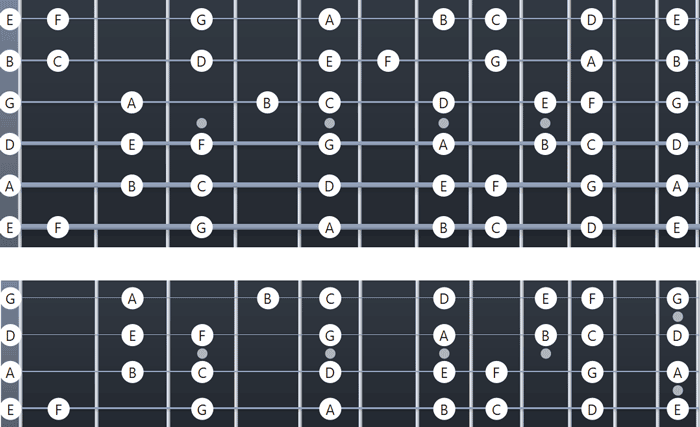
The lower four strings on a guitar match up perfectly with the typical four string bass.
If you already know the notes on the guitar fretboard, you also know the notes on the bass fingerboard.
If you don’t know the notes on the fretboard, follow this guide to memorize the fretboard using simple and effective methods.
Other techniques such as hammer-ons, pull-offs, and slides also carry over when you pick up a bass. You can even use a pick to play bass, so you could very quickly learn how to play a lot of riffs and bass lines the first time you pick up a bass.
If you are a guitarist and are interested in learning bass, I highly recommend it. Not only will you get a head-start from your guitar knowledge, but bass can be incredibly fun to play.
Learning to play bass also helps you come up with new ideas as a guitarist and become a better songwriter. The more you learn about bass, the easier it will be to talk and play with other bassists.
If you do want to try to learn bass, you can use your guitar amp as a basic starting point if you are careful not to overload it.
Keep the volume low so the speaker isn’t pushed too hard. Or use headphones if you’re worried about damaging your guitar amp.
Then if you decide you want to stick to playing bass, you can either buy a dedicated bass amp or use a hybrid guitar/bass amp like the Peavey Vypyr VIP 3.
To start learning how to play bass, check out these 6 Bass Guitar Exercises for Beginners to Practice Daily. These exercises will help you feel comfortable with the bass fingerboard and speed up the learning process.
Check out this guide for a step-by-step method to learning bass as a guitarist. This guide will help you make the transition from guitar to bass as easy as possible.
If you already have some guitar pedals, find out if you can use guitar pedals for bass in this guide.
To find out more about what other inputs your guitar amp can handle, find out how you can use your guitar amp as a speaker in this guide.
